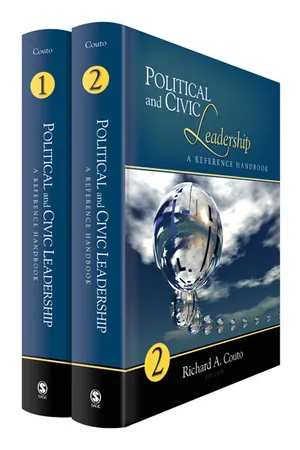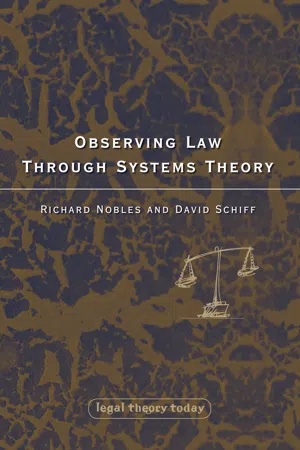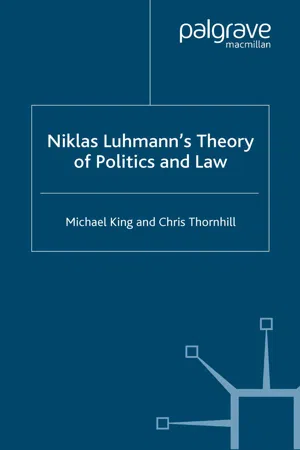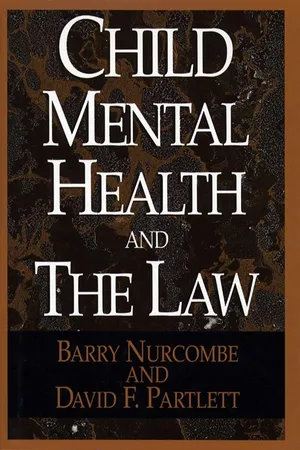Law
Legal System
The legal system refers to the framework of rules, institutions, and processes that are established by a society to regulate behavior, enforce laws, and resolve disputes. It encompasses various components such as legislation, courts, law enforcement, and legal professionals, all working together to uphold justice and maintain order within a society.
Written by Perlego with AI-assistance
Related key terms
1 of 5
5 Key excerpts on "Legal System"
- eBook - PDF
Political and Civic Leadership
A Reference Handbook
- Richard A. Couto(Author)
- 2010(Publication Date)
- SAGE Publications, Inc(Publisher)
50 L EGAL S YSTEMS A NDREW A. P AINTER Walsh, Colucci, Lubeley, Emrich & Walsh, P.C. A lthough not technically a legal term, the phrase Legal Systems conceptualizes the distinctive man-ner in which a particular society’s laws are admin-istered and depicts the various historical traditions, body of laws, procedures, and institutionalized functional units that form complex operational systems governing human interaction in a society. Although a review of legal sys-tems does not necessarily speak to an analysis of specific laws or areas of the law (i.e., criminal law, property, torts, etc.), it nevertheless includes what occurs when individu-als resolve or avoid disputes and the manner by which people may access the law and effectuate change therein. The phrase also connotes those rules that create and man-age a society’s unique interconnected institutions that are critical to the functioning of a Legal System, including law enforcement agencies, prosecutors, courts, facilities, and corrections. Throughout history, legitimate and pragmatic legal sys-tems have assisted in the crafting of advanced societies and have been effective in both enforcing societal norms and in encouraging behavior that is consistent with such norms. These normative values are often grounded in ethical con-siderations, which are largely based on consistent and well-founded moral duties derived from principles of right and wrong. Such ethical norms include internally defined rules that govern the conduct of a person, profession, or society and provide a guide to one’s life decisions. Although many laws incorporate basic ethical standards (i.e., calling on humans to refrain from theft, rape, murder, fraud, etc.), others may deviate from what a society con-siders moral and right (i.e., the condoning of slavery in the antebellum United States, imposition of apartheid in South Africa, etc.). - eBook - ePub
- Richard Nobles, David Schiff(Authors)
- 2012(Publication Date)
- Hart Publishing(Publisher)
Legal philosophers have persistently attempted to explain why we think of laws as forming Legal Systems, to evaluate the merits of this way of thinking about the law, and to make it more precise by explicating the features that account for the unity of Legal Systems. Various theories have been suggested but none have been accepted as completely satisfactory, and the continuing debate owes much to the intricacy of the problems involved’ (2009, 78). 5 1961/1994. It is not only legal theorists who represent law in this way, sociological and political theory analysis of law also characterises the operation of law in similar terms. For what is now a classic statement to this effect, see Friedman, 1975, ch 1, ‘The Legal System’. 6 Raz, 2009, 115–21. 7 Sampford, 1989. 8 Van de Kerchove and Ost, 1994. 9 Dewey 1901, quoted by Sampford, 1989, 14. There are, of course, many modern alternative definitions of system and systems, especially those that both inform systems science in itself and in relation to complexity science (see, for example, Castellani, 2009, 8: ‘the celebrated insight of complexity science: all social systems, by definition, are complex’; Urry, 2005). There might be some agreement about the most general definition of a system (such as that offered by Webster’s New World Dictionary: ‘a set or arrangement of things so related or connected as to form a unity or organic whole’) but this does not mean that modern theorists who explore systems, systems theory and systems science in depth, rely on the same definition or adopt similar methodologies in their study of systems. (Webster’s definition is quoted by Klir, 2001, who also says (at 4): ‘The term “system” is unquestioningly one of the mostly widely used terms not only in science, but in other areas of human endeavor as well. It is a highly overworked term, which enjoys different meanings under different circumstances and for different people - eBook - PDF
- M. King, C. Thornhill(Authors)
- 2003(Publication Date)
- Palgrave Macmillan(Publisher)
2 Society’s Legal System Preliminary points The Legal System Defining terms may seem a pedantic and unnecessary exercise, particular where the terms in question are used repeatedly and without apparent con- fusion both in popular parlance and academic texts. Yet the combination of subtle changes in concepts resulting from German to English translation, on the one hand, and the very specific meanings that Luhmann gives to terms such as ‘system’ within his theoretical scheme, on the other, makes it necessary for us to make it clear from the outset what he means by Rechtssys- tem, which we have translated by ‘Legal System’. It would perhaps be helpful from the outset to state what he does not mean. The ‘Legal System’ for Luhmann is not those institutions – legislative chambers, courts, tribunals, lawyers’ offices and chambers – which have a physical existence and are part of an organizational structure. Nor does it consist of all those people pro- fessionally engaged in the operation and administration of the law. Indeed, it does not consist of people at all. People are, of course, necessary for the operation of the Legal System, but das Rechtssystem does not refer to their personal characteristics or even to the roles that they perform within the courts and other legal institutions. Neither does it consist of ‘organized legal practice, that is mainly practice in the courts, parliaments and also occa- sionally in administrative organizations which make law based on delegated powers and law firms which channel legal access to the courts’. 1 Law, for Luhmann, is not subject to physical or geographical boundaries or defined by the status of individuals (judge, solicitor, law lecturer, court usher). An alternative translation of das Rechtssystem is ‘system of law’, which, unfortunately, in English tends to invoke the rather too narrow concept of the written law as set out in statutes and legal judgments. - eBook - ePub
- Barry Nurcombe(Author)
- 2010(Publication Date)
- Free Press(Publisher)
CHAPTER 2THE Legal System
THE NATURE AND PURPOSES OF LAW
A Functional Definition
T here have been many attempts to define the law; it would be inappropriate, in this chapter, to review the intricacies of this continuing debate. Instead, we shall explore the purposes, characteristics, sources, creation, and administration of the law in the American Legal System.American law has been greatly influenced by the positivist school of jurisprudence, which holds that there is a division between law and morality and that the law is primarily a body of rules incorporated in an assemblage of authoritative constitutions, statutes, regulations, case law, and legal conventions.The law is multifaceted. Public law regulates the relations of a citizen to his or her government, and the way that the departments of government relate with each other; whereas private law regulates the rights and obligations of citizens vis-à-vis one another. In some circumstances, this distinction becomes blurred. Tort law, for instance, was once regarded as being in the private domain since it dealt with cases in which one person would be legally obliged to remedy a wrong perpetrated upon another. Tort law thus adjusted the rights and obligations of private parties interacting with one another (an adjustment spurred by ideas of corrective justice). Today, however, tort law has evolved into a tool for the reallocation of social resources, much in the way that public law operates. In this sense, contemporary tort law is “public law in private law garb.” In contrast, contract law is more purely a private matter, for its rules are designed to facilitate commercial exchange.The Purposes of Law
Although the law is a body of rules, it is neither static nor immutable. The law changes, sometimes a little behind the times, but change it must, because its purpose is to facilitate interests and protect rights. Consequently, it may at times seem untidy or inconsistent. Oliver Wendell Holmes said: “The law is always approaching, and never reaching, consistency. It is forever adopting new principles from life at one end, and it always retains old ones from history at the other which have not yet been absorbed or sloughed off. It will become entirely consistent only when it ceases to grow.”1 - eBook - PDF
Ruling before the Law
The Politics of Legal Regimes in China and Indonesia
- William Hurst(Author)
- 2018(Publication Date)
- Cambridge University Press(Publisher)
Alleged causes of an outcome are measured by looking at aspects of the outcome itself. Without recognizing this sort of prob- lem, too many scholars, governments, and international institutions define benchmarks uncritically and then assess countries in relation to imagined “objective” rule of law standards (Serban 2015: 204–5). To steer clear of both the Scylla of fuzzy normativity and the Charybdis of tautological measurement, we must set aside the loaded concept of rule of law for purposes of dispassionate and systematic anal- ysis. Rather than trying to rank Legal Systems by how “good” or “bad” they are – or by how closely they align with an explicit or implicit Anglo-American ideal type – we ought to group Legal Systems into cat- egories defined by aspects of politics and the relationships of political institutions and actors to the work of the Legal System, rather than by substantive or formal dimensions of law itself. The concept of legal regimes accomplishes this task and allows for a better characterization and categorization of legal orders and systems. Legal Regimes: Outline of a Concept The most basic definition of a legal regime is a system or framework of rules governing some physical territory or discrete realm of action that is at least in principle rooted in some sort of law. Often the concept has been applied to specific areas of law, relating to American labor relations (e.g. Estlund 2002) or environmental protection of the Polar Regions (e.g. Joyner 1999), for example. Much of this work, in turn, ties closely into political science scholarship in international rela- tions, especially that which emerged in the 1980s under the banner of “regime theory” (e.g. Krasner 1983), emphasizing the development of shared rules, norms, and conventional practices that help shape actors’ expectations and behavior across national jurisdictions or between states in the international arena.
Index pages curate the most relevant extracts from our library of academic textbooks. They’ve been created using an in-house natural language model (NLM), each adding context and meaning to key research topics.




